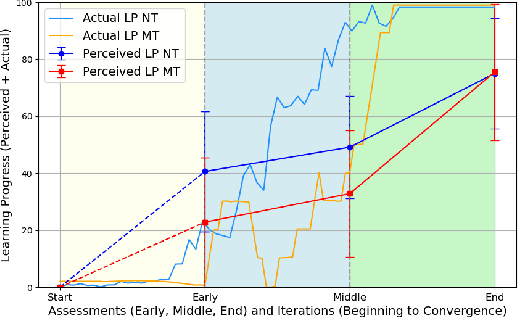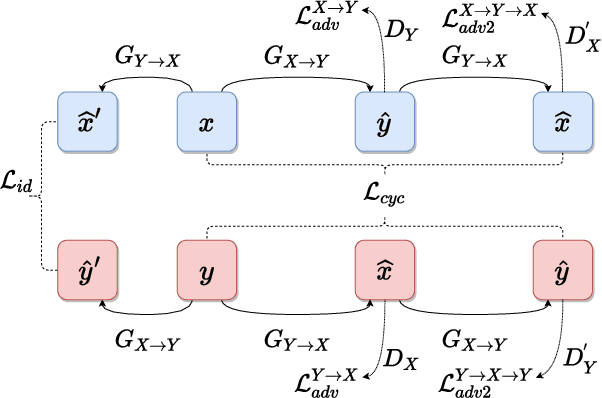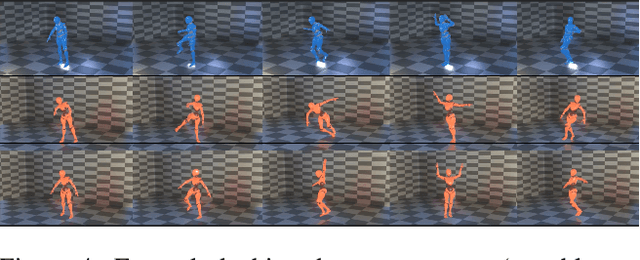Kim Baraka
A Systematic Review of Human-AI Co-Creativity
Jun 26, 2025Abstract:The co creativity community is making significant progress in developing more sophisticated and tailored systems to support and enhance human creativity. Design considerations from prior work can serve as a valuable and efficient foundation for future systems. To support this effort, we conducted a systematic literature review of 62 papers on co-creative systems. These papers cover a diverse range of applications, including visual arts, design, and writing, where the AI acts not just as a tool but as an active collaborator in the creative process. From this review, we identified several key dimensions relevant to system design: phase of the creative process, creative task, proactive behavior of the system, user control, system embodiment, and AI model type. Our findings suggest that systems offering high user control lead to greater satisfaction, trust, and a stronger sense of ownership over creative outcomes. Furthermore, proactive systems, when adaptive and context sensitive, can enhance collaboration. We also extracted 24 design considerations, highlighting the value of encouraging users to externalize their thoughts and of increasing the system's social presence and transparency to foster trust. Despite recent advancements, important gaps remain, such as limited support for early creative phases like problem clarification, and challenges related to user adaptation to AI systems.
Can you see how I learn? Human observers' inferences about Reinforcement Learning agents' learning processes
Jun 16, 2025



Abstract:Reinforcement Learning (RL) agents often exhibit learning behaviors that are not intuitively interpretable by human observers, which can result in suboptimal feedback in collaborative teaching settings. Yet, how humans perceive and interpret RL agent's learning behavior is largely unknown. In a bottom-up approach with two experiments, this work provides a data-driven understanding of the factors of human observers' understanding of the agent's learning process. A novel, observation-based paradigm to directly assess human inferences about agent learning was developed. In an exploratory interview study (\textit{N}=9), we identify four core themes in human interpretations: Agent Goals, Knowledge, Decision Making, and Learning Mechanisms. A second confirmatory study (\textit{N}=34) applied an expanded version of the paradigm across two tasks (navigation/manipulation) and two RL algorithms (tabular/function approximation). Analyses of 816 responses confirmed the reliability of the paradigm and refined the thematic framework, revealing how these themes evolve over time and interrelate. Our findings provide a human-centered understanding of how people make sense of agent learning, offering actionable insights for designing interpretable RL systems and improving transparency in Human-Robot Interaction.
Exploring the Effect of Robotic Embodiment and Empathetic Tone of LLMs on Empathy Elicitation
Mar 26, 2025Abstract:This study investigates the elicitation of empathy toward a third party through interaction with social agents. Participants engaged with either a physical robot or a voice-enabled chatbot, both driven by a large language model (LLM) programmed to exhibit either an empathetic tone or remain neutral. The interaction is focused on a fictional character, Katie Banks, who is in a challenging situation and in need of financial donations. The willingness to help Katie, measured by the number of hours participants were willing to volunteer, along with their perceptions of the agent, were assessed for 60 participants. Results indicate that neither robotic embodiment nor empathetic tone significantly influenced participants' willingness to volunteer. While the LLM effectively simulated human empathy, fostering genuine empathetic responses in participants proved challenging.
* *Liza Darwesh, Jaspreet Singh, Marin Marian, and Eduard Alexa contributed equally to this work.*
Robot Policy Transfer with Online Demonstrations: An Active Reinforcement Learning Approach
Mar 17, 2025



Abstract:Transfer Learning (TL) is a powerful tool that enables robots to transfer learned policies across different environments, tasks, or embodiments. To further facilitate this process, efforts have been made to combine it with Learning from Demonstrations (LfD) for more flexible and efficient policy transfer. However, these approaches are almost exclusively limited to offline demonstrations collected before policy transfer starts, which may suffer from the intrinsic issue of covariance shift brought by LfD and harm the performance of policy transfer. Meanwhile, extensive work in the learning-from-scratch setting has shown that online demonstrations can effectively alleviate covariance shift and lead to better policy performance with improved sample efficiency. This work combines these insights to introduce online demonstrations into a policy transfer setting. We present Policy Transfer with Online Demonstrations, an active LfD algorithm for policy transfer that can optimize the timing and content of queries for online episodic expert demonstrations under a limited demonstration budget. We evaluate our method in eight robotic scenarios, involving policy transfer across diverse environment characteristics, task objectives, and robotic embodiments, with the aim to transfer a trained policy from a source task to a related but different target task. The results show that our method significantly outperforms all baselines in terms of average success rate and sample efficiency, compared to two canonical LfD methods with offline demonstrations and one active LfD method with online demonstrations. Additionally, we conduct preliminary sim-to-real tests of the transferred policy on three transfer scenarios in the real-world environment, demonstrating the policy effectiveness on a real robot manipulator.
Active Robot Curriculum Learning from Online Human Demonstrations
Mar 04, 2025Abstract:Learning from Demonstrations (LfD) allows robots to learn skills from human users, but its effectiveness can suffer due to sub-optimal teaching, especially from untrained demonstrators. Active LfD aims to improve this by letting robots actively request demonstrations to enhance learning. However, this may lead to frequent context switches between various task situations, increasing the human cognitive load and introducing errors to demonstrations. Moreover, few prior studies in active LfD have examined how these active query strategies may impact human teaching in aspects beyond user experience, which can be crucial for developing algorithms that benefit both robot learning and human teaching. To tackle these challenges, we propose an active LfD method that optimizes the query sequence of online human demonstrations via Curriculum Learning (CL), where demonstrators are guided to provide demonstrations in situations of gradually increasing difficulty. We evaluate our method across four simulated robotic tasks with sparse rewards and conduct a user study (N=26) to investigate the influence of active LfD methods on human teaching regarding teaching performance, post-guidance teaching adaptivity, and teaching transferability. Our results show that our method significantly improves learning performance compared to three other LfD baselines in terms of the final success rate of the converged policy and sample efficiency. Additionally, results from our user study indicate that our method significantly reduces the time required from human demonstrators and decreases failed demonstration attempts. It also enhances post-guidance human teaching in both seen and unseen scenarios compared to another active LfD baseline, indicating enhanced teaching performance, greater post-guidance teaching adaptivity, and better teaching transferability achieved by our method.
SHARPIE: A Modular Framework for Reinforcement Learning and Human-AI Interaction Experiments
Jan 31, 2025


Abstract:Reinforcement learning (RL) offers a general approach for modeling and training AI agents, including human-AI interaction scenarios. In this paper, we propose SHARPIE (Shared Human-AI Reinforcement Learning Platform for Interactive Experiments) to address the need for a generic framework to support experiments with RL agents and humans. Its modular design consists of a versatile wrapper for RL environments and algorithm libraries, a participant-facing web interface, logging utilities, deployment on popular cloud and participant recruitment platforms. It empowers researchers to study a wide variety of research questions related to the interaction between humans and RL agents, including those related to interactive reward specification and learning, learning from human feedback, action delegation, preference elicitation, user-modeling, and human-AI teaming. The platform is based on a generic interface for human-RL interactions that aims to standardize the field of study on RL in human contexts.
Prosody as a Teaching Signal for Agent Learning: Exploratory Studies and Algorithmic Implications
Oct 31, 2024



Abstract:Agent learning from human interaction often relies on explicit signals, but implicit social cues, such as prosody in speech, could provide valuable information for more effective learning. This paper advocates for the integration of prosody as a teaching signal to enhance agent learning from human teachers. Through two exploratory studies--one examining voice feedback in an interactive reinforcement learning setup and the other analyzing restricted audio from human demonstrations in three Atari games--we demonstrate that prosody carries significant information about task dynamics. Our findings suggest that prosodic features, when coupled with explicit feedback, can enhance reinforcement learning outcomes. Moreover, we propose guidelines for prosody-sensitive algorithm design and discuss insights into teaching behavior. Our work underscores the potential of leveraging prosody as an implicit signal for more efficient agent learning, thus advancing human-agent interaction paradigms.
"Give Me an Example Like This": Episodic Active Reinforcement Learning from Demonstrations
Jun 06, 2024



Abstract:Reinforcement Learning (RL) has achieved great success in sequential decision-making problems, but often at the cost of a large number of agent-environment interactions. To improve sample efficiency, methods like Reinforcement Learning from Expert Demonstrations (RLED) introduce external expert demonstrations to facilitate agent exploration during the learning process. In practice, these demonstrations, which are often collected from human users, are costly and hence often constrained to a limited amount. How to select the best set of human demonstrations that is most beneficial for learning therefore becomes a major concern. This paper presents EARLY (Episodic Active Learning from demonstration querY), an algorithm that enables a learning agent to generate optimized queries of expert demonstrations in a trajectory-based feature space. Based on a trajectory-level estimate of uncertainty in the agent's current policy, EARLY determines the optimized timing and content for feature-based queries. By querying episodic demonstrations as opposed to isolated state-action pairs, EARLY improves the human teaching experience and achieves better learning performance. We validate the effectiveness of our method in three simulated navigation tasks of increasing difficulty. The results show that our method is able to achieve expert-level performance for all three tasks with convergence over 30\% faster than other baseline methods when demonstrations are generated by simulated oracle policies. The results of a follow-up pilot user study (N=18) further validate that our method can still maintain a significantly better convergence in the case of human expert demonstrators while achieving a better user experience in perceived task load and consuming significantly less human time.
Fine-grained Affective Processing Capabilities Emerging from Large Language Models
Sep 04, 2023Abstract:Large language models, in particular generative pre-trained transformers (GPTs), show impressive results on a wide variety of language-related tasks. In this paper, we explore ChatGPT's zero-shot ability to perform affective computing tasks using prompting alone. We show that ChatGPT a) performs meaningful sentiment analysis in the Valence, Arousal and Dominance dimensions, b) has meaningful emotion representations in terms of emotion categories and these affective dimensions, and c) can perform basic appraisal-based emotion elicitation of situations based on a prompt-based computational implementation of the OCC appraisal model. These findings are highly relevant: First, they show that the ability to solve complex affect processing tasks emerges from language-based token prediction trained on extensive data sets. Second, they show the potential of large language models for simulating, processing and analyzing human emotions, which has important implications for various applications such as sentiment analysis, socially interactive agents, and social robotics.
Dance Style Transfer with Cross-modal Transformer
Aug 22, 2022



Abstract:We present CycleDance, a dance style transfer system to transform an existing motion clip in one dance style to a motion clip in another dance style while attempting to preserve motion context of the dance. Our method extends an existing CycleGAN architecture for modeling audio sequences and integrates multimodal transformer encoders to account for music context. We adopt sequence length-based curriculum learning to stabilize training. Our approach captures rich and long-term intra-relations between motion frames, which is a common challenge in motion transfer and synthesis work. We further introduce new metrics for gauging transfer strength and content preservation in the context of dance movements. We perform an extensive ablation study as well as a human study including 30 participants with 5 or more years of dance experience. The results demonstrate that CycleDance generates realistic movements with the target style, significantly outperforming the baseline CycleGAN on naturalness, transfer strength, and content preservation.
 Add to Chrome
Add to Chrome Add to Firefox
Add to Firefox Add to Edge
Add to Edge